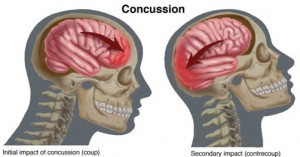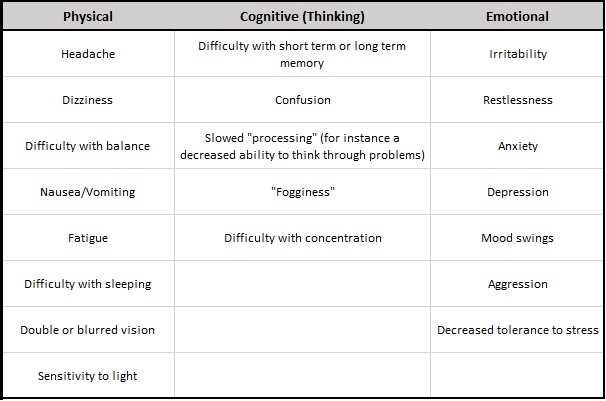Concussions
In recent years concussions and the associated long-term effects have become a hot topic in sports medicine. Controversy still exists among experts in the medical community on how these injuries can be best treated, managed and prevented but the prevailing research at this time supports a multi-system approach, tracking physical symptoms and symptom management, vestibular disruptions, cognitive impairments, and emotional effects, as well as monitoring appropriate mental and physical stresses for best return to play decision making and preparation.
What is it?
The CDC defines a concussion as “a type of traumatic brain injury… caused by a bump, blow, or jolt to the head.” It can be a hit to the body that causes the head and brain to move rapidly back and forth. This impact or acceleration/deceleration of the brain causes ‘neuronal shearing’ and chemical changes within the brain. These ‘cellular level’ changes are not typically detectable on imaging such as CT or MRI.
An athlete does not have to experience loss of consciousness to be diagnosed with a concussion. Here are some common symptoms.
Signs and symptoms
The first step is to get appropriate medical attention. If the athlete is on the field, he or she should be evaluated by a qualified health professional.
If the athlete is suspected to have a concussion, he or she should not return to the game.
Rest is crucial for the first 24-72 hours. The cellular level changes that take place with a concussion require a lot of energy (from the brain) to ‘reset’ back to its normal resting state. This creates a short term “energy crisis”, which typically presents as significant mental exhaustion.
A physical assessment following a concussion can identify any additional injuries associated with the impact. Cervical spine sprain/strain injuries are commonly found and can contribute to headaches. Additionally, an athlete may experience visual or vestibular disturbances. If not addressed, these impairments may contribute to continued headaches or dizziness even after the brain has healed!
It’s estimated that 80-90% of concussions resolve in 7-10 days. The prognosis is good, so long as the brain is given a chance to rest. Just like a sprained ankle requires time to heal; injured brain tissues need time to recover. This typically means limiting any strain for the first 2-3 days. Similar to a sprained ankle, however, we may begin to introduce some level of activity before the injury has fully recovered, so long as this return to activity is 1) gradual; and 2) not associated with worsening of symptoms.
The following are our best recommendation based on the best current research:
|
What is post-concussion syndrome?
Unfortunately, not all concussions resolve in the 7-10 day timeframe. Symptoms can linger and ‘Post-Concussion Syndrome’ (PCS) can develop. Broadly defined, the hallmarks of PCS include prolonged fatigue, headaches, dizziness, irritability, anxiety, insomnia, and difficulty with concentration or memory, as well as intolerance to cardiovascular exercise.
How Can We Help?
A Physical Therapist, Sports Medicine Professional or Pediatrician familiar with concussion management protocols can assist in setting appropriate goals and expectations. At VASTA Physical Therapy our therapists are specially trained in Assessment and Management of Concussion. The initial assessment will include a detailed cognitive assessment, balance/coordination testing, neurological testing and an evaluation of the cervical spine. If indicated we may also perform baseline vestibular screening. We will set initial limitations on activity guided by heart rate monitor on baseline tolerance for aerobic activity. Patients will be given a schedule for graded progression of activity. Patient will return at regular intervals for reassessment and modification of programs as indicated. Additionally we will provide vestibular therapy (if dizziness persists) and treatment for the cervical spine if needed. This can be essential in reducing upper cervical pain and tension type headaches that may accompany a concussion and may help with “cervicogenic” dizziness.
At VASTA we will guide and monitor a safe and gradual progression based on objective milestones to ensure the safety of the athlete. We communicate and coordinate with your Physician to implement best practices in returning the athlete back to sports/activity.
Baseline Testing:
VASTA Physical Therapy offers baseline concussion testing. This baseline testing consists of both a computerized cognitive test as well as a balance (vestibular) test to establish individualized standards in the event an athlete sustains and needs to be evaluated for concussion. The ImPACT computerized concussion testing and assessment is a nationally recognized tool that has been scientifically validated by third party researchers for helping to assist with safe return to play decisions. Used by professional sports teams, high schools, colleges, military units, and performers, ImPACT is the country’s most widely used computerized concussion evaluation system. By establishing a baseline for you or your athlete’s cognitive and vestibular functioning, concussion management and return to play can better be tailored to you or your athlete’s specific normative values. Click here for additional information.
The baseline test should be repeated annually for children ages 10-12, every two years ages 13-17, and once every four years for 18+.
*This testing takes about 45-60 minutes for an individual.
*We offer individual tests for $75, this cost includes a consultation, ImPACT computerized concussion testing and assessment, and the Balance Error Scoring System (BESS) test. Discounted group rates are available for full team testing.
*Call VASTA Physical Therapy at 802-399-2244 to schedule your baseline evaluation
It is important to note that many high schools are now using cognitive tests such as ImPACT to determine if an athlete is ready to return. While these tests can be important tools and do provide some insight into recovery, they do not take the place of a proper comprehensive assessment, and should not be the sole factor for return to play decisions.





Leave a Reply
Want to join the discussion?Feel free to contribute!